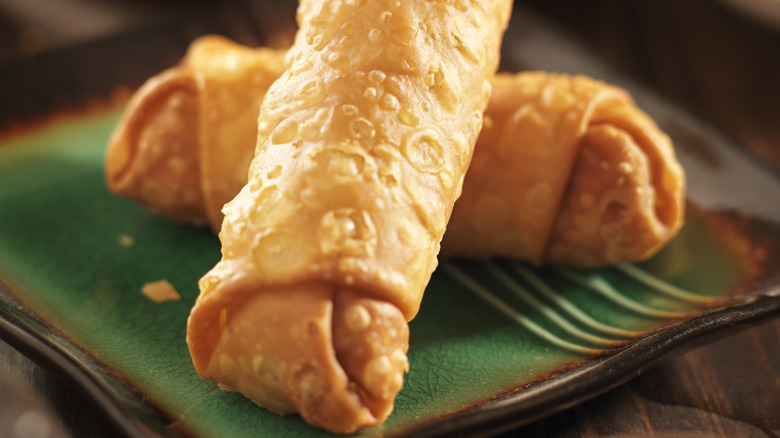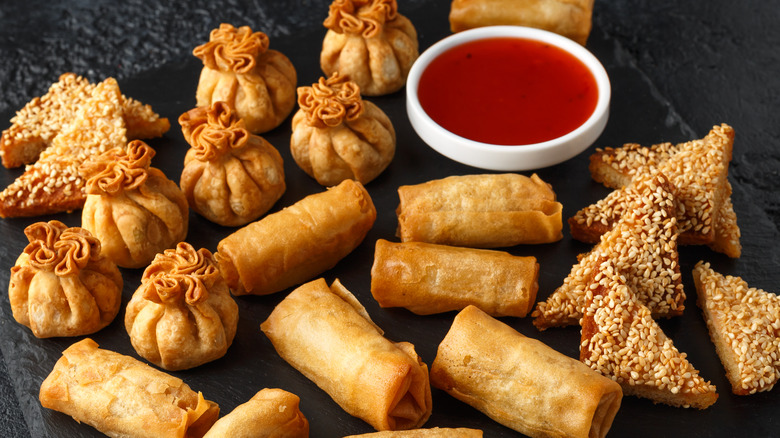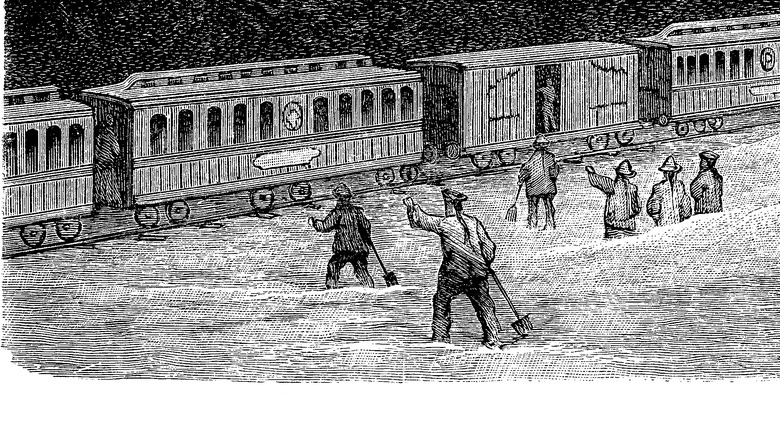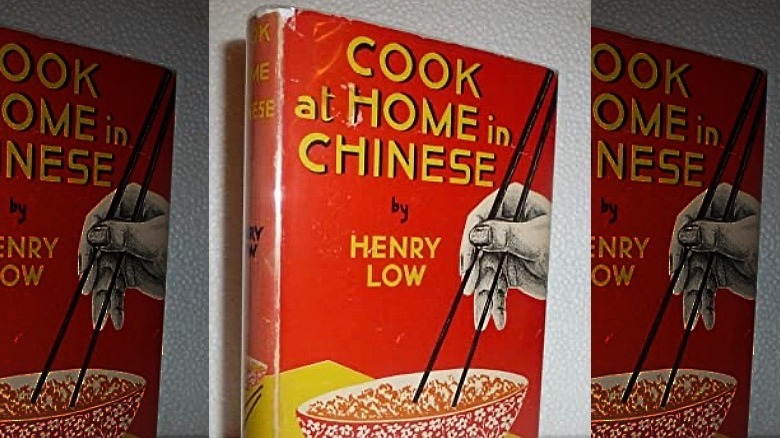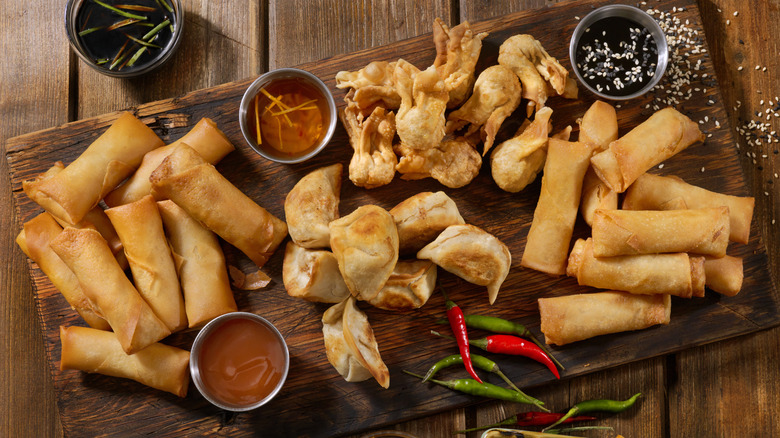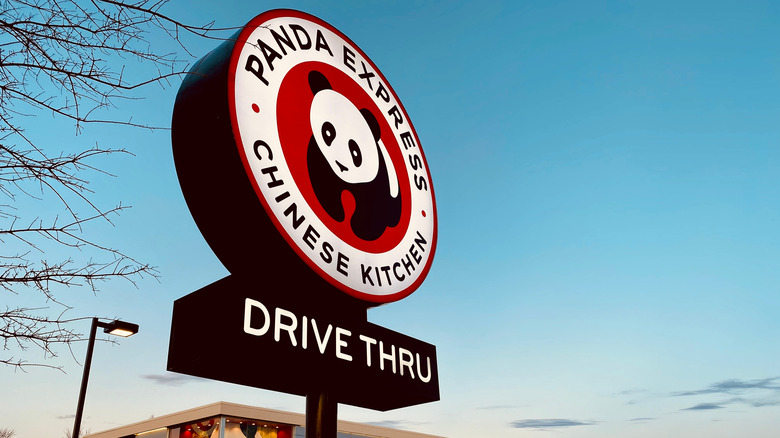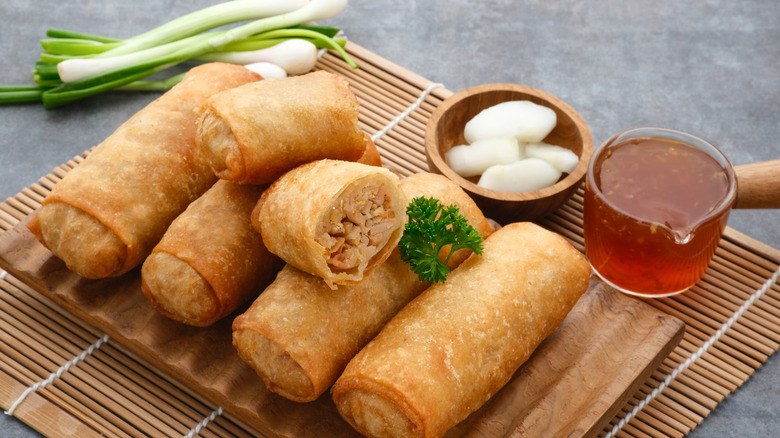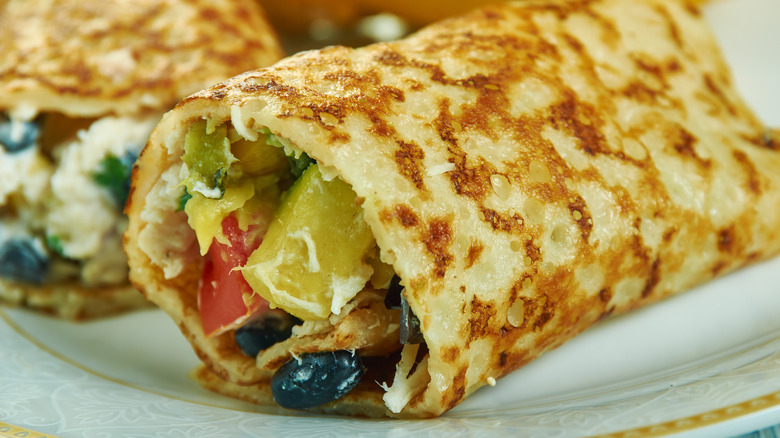The Rather Mysterious Origins Of The Classic Egg Roll
Crrrunch! Egg rolls hit every note of the perfect comfort food: They are nostalgic, fried, salty, and can be dipped in something sweet. This Chinese-American dish has long been a mainstay of takeout menus, often served as an appetizer or as part of a lunch or dinner combo. (That said, some menus are more egg-roll forward, forgoing the other dishes altogether.) They come filled with veggies and sometimes meat, wrapped in a floury shell.
But where did this dish originate? Is it an "authentic" Chinese dish or is it a Western invention? And beyond that, how has the egg roll changed through the years? What even is an egg roll? So many questions. This one seemingly simple dish has some somewhat mysterious origins. Even though not everyone eggxactly eggrees on the answers to these questions, there are some general theories that create some food for thought. Let's look at them and the likelihood that they're correct.
Theory 1: Was it the ancient Chinese?
The first theory goes a long way back. Some contend that the egg roll (or egg-roll-like foods) date back to ancient China, stating that they are a relative of the wonton.
Most food historians agree that wheat-based foods — like noodles (sorry, Italy) — originated in northern China. The precursor to the wonton dates back to medieval China, says research published in the Journal of the American Oriental Society, Vol. 117, No. 2.
Those who subscribe to this theory say that egg rolls and their eggless siblings, the spring roll, were an essential part of Cantonese dim sum menus. Traditionally, spring rolls were tea-time snacks served around Lunar New Year according to "The Thousand Recipe Chinese Cookbook."
In essence, those who think theory one is correct believe the trajectory goes like this: Wontons → spring rolls → egg rolls. They don't necessarily agree about the exact time or place that egg rolls were invented. Still, because they relate egg rolls to spring rolls and wontons, they believe ancient China is the origin of this takeout classic.
Theory 2: Was it railway workers?
If it wasn't the ancient Chinese, who could it be? The second theory is that egg rolls were "invented" by mid-19th-century railway workers. It's possible 1800s railway workers, the first Chinese settlers in the U.S., invented the eggroll — or at least, that that is when it came to the United States. According to Mental Floss, during the 1800s, railway workers were the primary consumers of Chinese food in North America. According to The Smithsonian, at this time, up to 15,000 Chinese people (mostly men) immigrated to the U.S. to work on the Central Pacific Railroad. Most came from the southern Chinese province of Guangdong. They faced racism, low wages, and difficult living and working conditions.
There were also white workers on the railroads; those running the restaurants for immigrant Chinese workers sought to create cuisine that appealed to both crowds. Food Timeline corroborates that the first Chinese immigrants to the U.S. in the mid-19th century likely ate egg rolls.
Theory 3: Was it Henry Low?
If not railway workers, then who? The third theory about how egg rolls came about is that a chef named Henry Low invented them. He wrote a cookbook in 1938 entitled "Cook At Home In Chinese," in which a recipe for Tchun Guen or dan gun ("spring roll") appears. But this was a literal egg roll. While the filling was the ingredients we're familiar with today. The major difference was the wrapper. It was no wheat wrapper like we know today. The meat and veggies were bundled up in an omelet-like layer.
However, some people, including those at Sampan, are dubious about whether Low is the actual inventor of the egg roll. Because while he was a New York chef and the recipe did appear in his book, the only real evidence that he invented the dish is his word. Apparently, there are even earlier printings of egg roll recipes. So, this is not the most likely of theories.
Theory 4: Was it Lum Fong?
Henry Low isn't the only chef that's been named as the egg roll's original inventor. Another proposal is that Lum Fong, another New York chef, may have created the egg roll in 1925 — this is Sampan's preferred theory. The dish was super popular at Fong's restaurant. The news outlet goes on to say that the Brooklyn Daily Eagle (N.Y.), May 14, 1934, referenced "Lum Har Chun Guen," a lobster egg roll, as a dish at Lum Fong's Restaurant. The first printed recipe, also Lum Fong's, was published around the same time. The following year, papers in other states began mentioning this dish, many of which referenced Lum Fong as the creator. Newspapers into the 1950s credited Lum Fong as the inventor of the egg roll, or at the very least, the chef who introduced the dish to U.S. Americans. With outside evidence that Lum Fong created the egg roll, it's more likely that he created it than Henry Low did.
The truth? It's probably a mix
There's likely some truth to all these theories because it depends on what you consider an invention. Furthermore, American Chinese food is a distinct regional cuisine with a specific diaspora history. Xiran Jay Zhao explains in a YouTube video that immigration patterns have much to do with how Chinese American cuisine has developed. The first immigrants to arrive were from southern China — where food is sweeter and dim sum is popular. They were also male laborers who traditionally didn't know how to cook. They needed to adapt quickly and use local ingredients in their foods.
Later, due to racism, Chinese people couldn't really find jobs outside of starting their own businesses, such as restaurants. Eventually, when Chinese immigration became legal again, American Chinese foods were so popular that Chinese associations helped newcomers set up restaurants across the country — leading to a ubiquity of menus and dishes available that would be pleasing to the U.S. American palette.
So, with these immigration patterns and how American Chinese food spread and popularized across the United States, it's likely that no one theory about how the egg roll came to be is incorrect or correct.
Variations on the egg roll
Egg rolls are unique but also not. They are very similar to the spring roll and often get compared or confused with one another. What's the difference between spring rolls and egg rolls? Well, it can depend on who you ask. Mental Floss says the easiest way to tell the difference is the shell; the outlet states that if it resembles a deep-fried flour tortilla, you're likely dealing with an egg roll. That thickness creates another important distinction, says Izzy Cooking. Egg roll fillings are pre-cooked, while spring roll fillings, usually wrapped in a thin rice paper before frying, are not. The thin coating allows the filling to cook during the fry.
Many countries have their own versions of the egg roll, including Filipino lumpia and Vietnamese chả giò. According to Culinary Specialties, the main difference between egg rolls and lumpia is that lumpia can be fried but doesn't have to be. Though often nicknamed "Vietnamese egg rolls," Vietnam Nomad describes chả giò as deep-fried spring rolls. The ingredients can vary but the important thing is they are made from raw ingredients wrapped in rice paper before frying. And Australia has the chiko roll, a large and chewy version of an egg roll.
Egg rolls today
How have egg rolls changed over the years? For one thing, a modern egg roll doesn't even need to contain eggs, says Van's Kitchen (even though one of the original egg rolls was basically an omelet). You can use water as glue to hold the wheat wrapper together rather than egg.
The modern egg roll need not contain egg. And many versions, including the "southwestern egg roll," don't even contain Chinese ingredients. Besides southwestern egg rolls, you can also get your hands on brisket egg rolls and even Reuben egg rolls these days. The sky's the limit!
But it's not just fillings that have gotten creative. For instance, if you want to make something a little lower fat, you can even make your egg rolls in the air fryer. That goes for reheating and making them fresh. While the exact origin of the egg roll may remain a mystery, the one thing that isn't a mystery is how delicious they are. Which is your favorite version?
